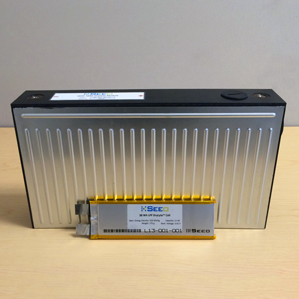| Captor E-Scan radar system installed aboard BAE's IPA5 development aircraft (Photo: BAE Systems) BAE Systems is in the process of developing and testing a next-generation radar system for the Eurofighter Typhoon. The Captor E-Scan, fitted in the nose-cone of the fighter, boasts a number of improvements over other Active Electronically Scanned Arrays (AESAs), including a wider field of regard and the provision of advanced electronic warfare protection. Many of the improvements over the current generation of radar systems are due to the sheer size of the array, coupled with the novel re-positioning mechanism upon which the plate is mounted. The ability to re-position the array inside the protective environment of the fighter's nose-cone represents a significant operational advantage over traditional fixed-plate AESA radar systems, with the extra movement allowing for a 200-degree field of regard, roughly 50 percent wider than that offered by the traditional model. Furthermore, the enlarged aperture of the plate allows for more transmitter receiver modules (TRMs) to be fitted, and this in turn allows the system to detect aircraft from farther away and with greater fidelity. In its finished form, the Captor-E plate boasts more than 1400 TRMs, roughly 60 percent more than aircraft equipped with fixed-plate AESAs. According to BAE, these advances will allow the Captor E-Scan system to outstrip its competitors across the board, offering greater detection range and therefore first fire capability, along with reduced tracking latency and advanced air-to-surface capabilities. BAE has also endeavored to reduce the number of moving parts required for the system to function, with the effect of reducing the risk of mechanical failures during flight while lowering the difficulty of maintenance. "This is a major step forward in the development of Typhoon. From the outset, the aircraft was built with capability enhancement in mind and this step is proof that we are developing Typhoon to keep it relevant for today and for the future," stated Managing Directer of the Combat Air at BAE, Martin Taylor. "Typhoon has become the backbone of a number of air forces and with the potential for further development it will be meeting the needs of modern warfare for decades to come." The Captor E-Scan radar has already begun flight testing, with a dummy unit making its first flight aboard the company's IPA5 development aircraft in July this year. In terms of compatibility, the system is currently designed for integration aboard Tranche 2 & 3 Eurofighter Typhoons, with the possibility of modifying Tranche 1 aircraft to carry the system. BAE boasts that once operational, the new system will cater to client nation's operational needs up to and beyond 2040.
Source: BAE Systems
|












